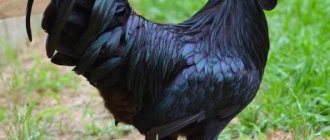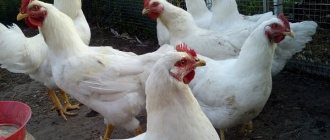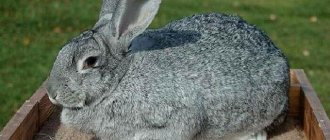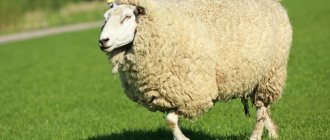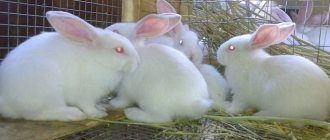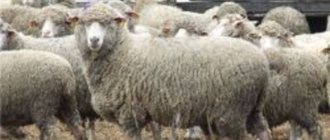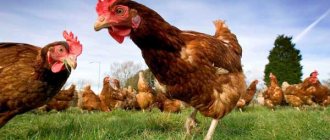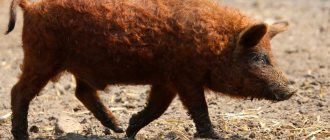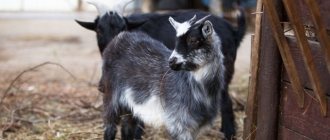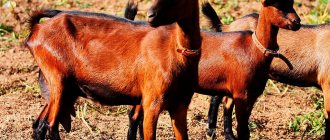The Caucasian and North Caucasian sheep breeds were bred in the Stavropol Territory. Now these animals are bred mainly in the south of Russia or in neighboring countries with a similar climate. Breeding sheep of these breeds is a profitable undertaking due to their high productivity in both meat and wool.
Caucasian breed of sheep
Description and characteristics of the breed
Animals of the Caucasian breed are distinguished by their proportional physique, elongated and rounded body. Adult males gain weight up to 120 kg, females - up to 70. Rams grow at the withers up to 75-77 cm, females - up to 70 cm.
The breed also shows good performance in terms of wool: 8-9 kg of wool is sheared from a ram, 7-8 kg from a sheep, the length of the fibers is 10 and 8 cm, respectively. The fleece is usually a pastel cream color with a whitish tint. The yield of pure wool is 55-56%.
Expert opinion
Zarechny Maxim Valerievich
Agronomist with 12 years of experience. Our best country expert.
Ask a Question
Once a year, the female gives birth to offspring (usually 1-2 lambs). During lactation, milk yield can be 100 liters of milk with a fat content of 5 to 8%. Therefore, lambs recover quickly and already at the age of four months gain weight of 35-40 kg.
North Caucasian meat and wool breed
Semi-fine-fleece meat-haired long-haired breed. Bred (1944-1960) into the Stavropol Territory breeding stock by crossing fine-wool ewes with rams of the English Lincoln and Romney-Marsh breeds, selecting first-generation crossbreeds of the desired type and breeding them “inside.”
When breeding crossbred animals of the first generation “in themselves,” it was found that the offspring of Lincoln rams were superior in their economic and useful qualities to crossbreeds obtained from Romney-Marsh rams. Half-bred animals from Lincoln rams had large stature, a relatively long body, rounded shapes, fleece of staple and staple-braided structure, wool with large crimp, luster shine, silky; the thickness of the fibers was predominantly 50-56 quality, length 10-14 cm. The offspring of Romney Marsh rams were inferior in these indicators to animals obtained from Lincoln rams. Therefore, the use of Romney Marsh rams was discontinued in 1948.
The modern herd of North Caucasian meat-wool sheep is characterized by large growth, regular body shape and a good combination of high meat and wool productivity. Animals have a strong constitution with well-developed bones. The head is wide, the rams and uteri are polled, the rudiments of the horns without a bone base are not considered a major fault. The neck is medium length, fleshy. The withers, back, loin and sacrum are wide. The chest is quite wide and deep with a prominent dewlap. The ribs are rounded. The body is long with strong limbs. The thighs are quite well done. Overgrowth of the head to the line of the eyes, legs to the carpal and hock joints.
The covering hair is white. Small dark spots on the nose, ears, legs are allowed.
Fleece of staple and staple-braid structure. The color of the grease is white and light cream. The wool is white, uniform with a clearly defined curl (2-3 curls per 1 cm of length) and a semi-luster sheen, good to medium density, equalized in fleece and staple.
The length of the wool is 12-13 cm, the fineness is 56-50 quality, the crimp is large, well defined along the length of the staple. Sheared ram wool 9-12 kg, ewes - 5.5-6.0 kg with a washed fiber yield of 58-62%.
Live weight of rams is 90-100 kg, ewes -55-58 kg. Under conditions of abundant feeding, 45 lambs at the age of one year weighed on average 70.1 kg, and 40 rams - 86.1 kg. The maximum live weight among lambs was 85 kg, among rams - 119, among rams - 150, among queens - 129 kg. Sheep have good feeding and slaughter qualities. When feeding on Sudanese crops with feeding with concentrates, the average daily gain of valushki was 200 g. At slaughter at 8 months of age, their carcasses weighed 21.4 kg, the slaughter yield was 50.1%, the pulp content in the carcass was 78-79%.
The fertility of queens is 120-130%.
The best population of sheep of the North Caucasian breed is found in the breeding grounds of the Stavropol Territory, as well as in the breeding grounds and breeding farm “Malo-Kabardinsky” of the Kabardino-Balkarian Republic.
Pros and cons of Caucasian and North Caucasian sheep
Due to the high quality of the fleece, sheep wool is used to produce clothing. The popularity of the breed is also explained by other positive qualities:
- individuals grow large in size and quickly gain weight (one-year-old females weigh 65-70 kg, males gain weight up to 120 kg);
- from one carcass a large meat yield of 55-60% is obtained;
- high fertility of Caucasian females (100 females give birth to 140 lambs per year);
- Animals of the North Caucasian breed grow and develop well in arid climates.
See also
Description and characteristics of Kuibyshev breed sheep, maintenance rulesRead
A negative quality of Caucasian sheep is that the wool grows unevenly on individual parts of the body. Most often on the head and abdomen. Lambs of the North Caucasian breed are sometimes born with sparse wool.
We cut according to schedule
The North Caucasian breed of sheep is not subject to seasonal shedding, but this does not mean that they can be sheared at any time. At the end of winter and beginning of spring, the wool of semi-fine wool sheep becomes dry and hard. This is due to the lack of fat in the fleece. In addition, the fatness of the sheep is of great importance - the better fed they are, the smoother and denser the skin, and the better fat production.
The optimal time for shearing adult semi-fine wool sheep is spring. Moreover, it is best to wait a few weeks after the animals are released to pasture.
During this period, the fleece will be cleared of the bedding material on which the sheep stood during the cold season, and a sufficient amount of grease will be produced so as not to damage the skin and wool during shearing. Spring lambs are sheared for the first time in the following spring. During winter lambing (in January or February), young animals can be shorn for the first time in the year of birth from mid to late August.
Maintenance and care
During the hot summer period, in grazing areas it is necessary to provide animals with a resting place and access to fresh, clean water. In winter, insulated rooms without drafts are suitable for keeping sheep. On frosty days, the temperature in the sheepfold should not fall below 12-14 °C. Wooden panels are used to form individual pens.
A prerequisite is the presence of a hard floor (on a soft surface, animals may experience problems with ligaments). The best option is to cover the concrete floor with plank flooring. To make it easier to maintain cleanliness, the floor is laid with a slight slope to allow natural waste drainage.
Zoological classification
The zoological classification of rams is based on the length and shape of the tail. This is a conditional systematization of animals belonging to different subgroups. It is also called morphological.
Classification according to zoological principle:
- short-tailed with a skinny tail (northern, Romanovskaya);
- long-tailed with a skinny tail (fine-fleece and semi-fine-fleece breeds);
- short-tailed with fatty deposits in the tail area (Telenginskaya, Buryatskaya, Kulundinskaya);
- long-tailed with fatty deposits in the tail area (Kuchugurovskaya, Georgian, Karakul);
- fat-tailed breeds with a short, underdeveloped tail (Asian fat-tailed breeds).
Nutrition rules
It is recommended to allocate a separate feeder for each sheep in the sheepfold. The drinking bowls are set to be voluminous, since an adult can drink up to 10 liters of water per day. The diet is divided into summer and winter. In the warm season, the basis of nutrition is green grass from pastures. In winter, dry food and succulent food are combined.
Approximate daily diet for an adult animal: 2-2.5 kg of silage, 1.5-2 kg of hay, 0.5-1 kg of feed.
Naturally, the portions of adult animals and lactating females are larger than those of young animals. Free access to minerals must be ensured. To do this, separate feeders are filled with chalk, bone meal and table salt.
Shearing indicators
The wool productivity of sheep is determined by the volume of shearing and production of pure wool, as well as the quality characteristics of the fibers.
Find out what an electronic sheep shepherd is.
The table shows the shearing indicators of the described sheep breeds:
| Sheep breed | Volume of clipping per year, kg | Pure fiber yield, % |
| Soviet merino | 10–12 | 43 |
| Australian Merino | 9–12 | 53 |
| Askani Merino | 16–19 | 42–45 |
| Grozny Merino | 10–16 | 47–50 |
| Altai Merino | 12–14 | 50 |
| Stavropolskaya | 15–19 | 40–44 |
| Karakulskaya | 3,5–5 | 20–50 |
| Tushinskaya | 3–5 | 55–60 |
| Tsigaiskaya | 6–7 | 58–60 |
| Kuibyshevskaya | 3,5–6 | 55–65 |
| Caucasian | 7,5–9 | 50–58 |
| Romanovskaya | 2,5–3,5 | 65–80 |
| Pomeranian | 4,5–7,5 | 50–60 |
| Lincoln | 6–14 | 65 |
| Merinoland | 4–7 | 40–50 |
Karakul breed of sheep
The oldest breed of sheep is distinguished by its adaptability and endurance in desert and semi-desert conditions. The live weight of females is 45-50 kg, rams - 70-80 kg. There are three types of Karakul sheep: strong, rough and tender. Based on the color of their skins, animals are divided into black, gray, brown, sur of various shades, white and pink. Lambs are usually born black in color. The gray color is then obtained from a combination of white and black fibers. Harsh skins are especially valuable (black fur has light or brown tips, which gives a golden or silver tint). Karakul sheep, due to long-term purebred breeding, are distinguished by stable heredity and are used to improve coarse-wool sheep. Crossing with this breed of sheep gives more and more new colors of broadtail, which always has a stable and successful market. Karakul sheep are bred mainly in the countries of Central Asia: Uzbekistan, Turkmenistan, Tajikistan, Kazakhstan.
Edilbaevskaya breed of sheep
An interesting breed of sheep bred in Kazakhstan, brown and red, polled, large individuals (the ewes weigh 7075 kg, rams - 105-115 kg), fat-tailed. Edilbaevsky sheep are still bred by purebred breeding in Kazakhstan with the aim of stabilizing heredity and subsequent use for improving fat-tailed breeds. In sheep farming, as we see, both purebred breeding and crossbreeding are used. Hybridization or interspecific crossing also occurs.
Share
Soviet merino sheep breed
This breed of sheep was created in the USSR on the basis of the Mazaevskaya and New Caucasian breeds, improved by Ramboulier rams, followed by absorption crossing with Merino rams. Subsequently, this breed of sheep was repeatedly improved by the Askanian, Caucasian, Stavropol, Grozny and Altai breeds and became most widespread in the CIS - from Siberia, Kazakhstan to Kalmykia and the Rostov region. It is distinguished by good wool productivity (wool clipping -3.0-3.3 kg), fertility 120-130 lambs per 100 ewes, live weight of sheep - 55-60 kg, rams - 110-120 kg. Animals of this breed are well adapted to the dry steppe climate and to being kept on pastures. The gene pool of Soviet merino sheep is successfully used to improve coarse wool sheep.
Business plan for sheep breeding: accounting for expenses and income
For example, you can take an average farm with a herd of 500 sheep:
- For such a livestock you need 25 hectares of land, which will be divided into plots and sown with grass throughout the spring-summer season;
- The price for renting land in the middle zone is from 100,000 rubles per month;
- Purchase of livestock – from 100,00,000 rubles (from 5,000 rubles for a purebred sheep);
- Feed in winter - from 180,000 rubles.
In the income column, the main item will be the sale of meat. The price per kilogram starts from 100 rubles. From selling the meat of 100 sheep you can earn up to 1,000,000 rubles. Thus, the profitability of the business will be 25%. The farm will reach self-sufficiency after 2 years of operation.
The following will help increase profitability:
- increasing the number of animals to 1000 or more;
- shifting the slaughter schedule closer to the beginning of spring, when the cost of meat increases significantly;
- meat processing (stew or sausage production workshop, smokehouse);
- sale of sheep milk and products made from it (primarily cheese);
- sale of hides and wool to wholesale suppliers. The profit will be small, but stable and will not require additional financial investments;
- sale of breeding young animals.
Sheep breeding as a business: features of product sales
Most often, lamb is sold on the market, trading it personally or with the help of hired sellers. It is not profitable to hand over meat for processing. Meat processing plants prefer to work with large farms, and the wholesale price of meat is significantly lower than the market price.
A promising option is working with restaurants. High-quality mutton and lamb are in great demand, so long-term contracts can be concluded. An equally convenient client is the owner of a small meat processing shop, who relies on expensive and high-quality products.
An approximate business plan for breeding geese at home and step-by-step instructions for creating your own goose farm are in this article.
Master meat processing yourself. Lamb can be smoked, stewed meat, sausages, and snack sets can be prepared from it. Processed meat lasts longer, and its price increases significantly. You can sell products via the Internet, private stores or markets.
Tsigai breed of sheep
This breed of sheep is one of the oldest in Asia Minor. Brought to Russia at the beginning of the 19th century. Sheep have a large constitution and good physique, and make good use of pastures. The uteruses are polled, the rams are horned. Fertility - 120-130 lambs per 100 queens, live weight of queens - 45-50 kg, rams - 90-10 kg. The wool clipped from queens is 3.5-4 kg, from rams - 6 kg. Sheep of the Tsigai breed have good feeding qualities and early maturity. Tsigai sheep breeds are bred in Russia (Rostov, Saratov regions) and some other regions of the CIS (for example, in the Azov regions of Ukraine).
Features of cutting fine wool breeds
You can shear a sheep for the first time in the spring. It is first necessary to bathe the animal 2 weeks before: it is during this period that the wool is of the highest quality. If desired, you can choose any other time of year. It all depends on the age of the pet.
You should prepare for a haircut in advance. At this point, the animal should have a fairly large weight. To cut your pet's hair, you need to prepare special tools in advance.
The process of shearing fine wool breeds
The process itself does not take much time, especially since the sheep do not resist during shearing. The pet needs to be laid on a wooden surface and you can safely begin the process. After shearing, the wool needs special treatment. To do this, you need to prepare a soap-soda solution. In it you need to wash the products 3 times, and then simply dry them.
Stavropol breed of sheep
This breed of sheep was bred in the Stavropol region of Russia in 1950 by crossing New Caucasian sheep with American Ramboulier rams, followed by the infusion of Australian Merino blood. Animals with a unique coat length (up to 12-14 cm) were obtained. The early maturity of sheep is average. Fertility is 130-140 lambs from 100 queens. The live weight of sheep is 55-60 kg, rams - 100-120 kg. The starting material for breeding the Stavropol breed of sheep was the New Caucasian merino sheep, which stocked the herd of the Soviet Fleece state farm. However, they were not densely coated, had low live weight and unsatisfactory conformation. At first, New Caucasian merino sheep were improved by breeding “inside”, then, in order to quickly achieve the desired results, the queens began to be crossed with Ramboulier rams imported from the USA. The offspring of these rams were superior to the maternal breed in size, strength of constitution, and body shape, but in terms of cut and quality of wool they were worse. Sometimes representatives of this breed exhibit conformation defects (closeness of the hocks, pendulous rear). Stavropol sheep are bred in the region of the same name, in the North Caucasus and in the Rostov region.
Prekos sheep breed
The Precos sheep breed was bred in the 19th century in France by crossing Merino Ramboulier sheep with rams of the English long-wool Leicester breed. At the same time, the same breeds of sheep were bred in Germany, where they were called meat merino sheep. In the CIS, this breed, along with Soviet merino, was widely used to improve coarse-wool sheep. The ewes and rams are polled, the fertility is 125-135 lambs per 100 ewes. The live weight of sheep is 55-67 kg, rams - 110-130 kg. The disadvantage of the breed should be considered low early maturation and sparse wool, the cut of which does not exceed 2.6 kg with a length of 8.5-9.5 kg. Prekos sheep are bred in almost all regions: Russia, Ukraine, Belarus.

